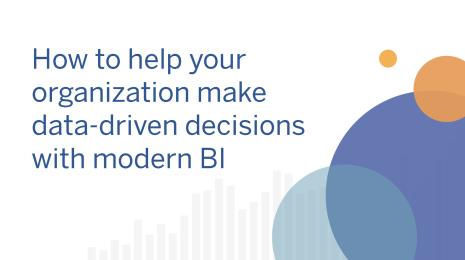Value series: How do you evaluate technology for transformation?

Editor’s note: This the first post in a series about the value of modern analytics for enterprise transformation.
In our age of digital transformation, IT leaders are feeling increased pressure to align initiatives to business strategy and outcomes—and new technologies can help on this journey. You might be tempted to say, “Let’s just pick one and figure it out.” But if your goal is to drive transformative change across your organization, you can’t rely on the technology evaluation process of the past. Keep these considerations in mind while you edit your evaluation checklist for transformative impact.
How is the technology used to solve business problems?
Features and capabilities are foundationally important in selecting technologies, but there’s no checklist to determine whether a piece of software will drive change or encourage innovation in your organization. While IT and the business have baseline needs (“Does it do the things it’s supposed to? Does it integrate with other systems?”), there are some tangible things you should think about to get a better sense for transformative potential:
Separate the result from the methods — Sometimes innovation requires a departure from traditional approaches where there may be immense value in a new way to get to results. For example, dashboards are often the main method for sharing analytical information across the business, but it's not a dashboard that a user is after—it’s insight. A truly innovative solution might depart from typical workflows and deliver value in a new way. With modern analytics, the people who know their data the best have power to explore it and the potential to unlock other insights along the way.
Look to enable cross-functional collaboration — Collaboration breaks down silos and connects people who can share information, ideas, and best practices. The primary benefits of a cloud ERP system, for example, is to integrate systems across lines of business. Connecting people and systems can also inspire innovation by introducing new use cases and applications of technology or shared information. Consider how your technology enables collaboration and sharing as you deploy and scale.
Don’t discount the importance of fun and creativity — Tools that unleash people’s creativity while retaining their power and flexibility make work more engaging. Simple interfaces that allow for creativity in tackling complex challenges help users focus their time and energy on the business problems at hand, rather than learning how to use the technology. And when learning is required, user experiences that people love will make them more likely to invest time and attention to developing skills. Strong engagement with the solution can also lead to more interesting and serendipitous experiences that not only help users find solutions to their known problems—"known unknowns”—but discover and explore “unknown unknowns.”
What does the technology offer in addition to its capabilities?
Even with the best tool for the job, you can’t force transformation in your organization. You have to mitigate risks and navigate change management, or else you won’t have the opportunity to deliver on the new technology’s potential. Even for products that appear commoditized, there are several important considerations outside your standard feature checklist that can indicate value toward protecting your investment:
Think about adoption, growth, and support — What resources are available to help users onboard and continuously develop their skills? If you can streamline creating a center of technical practice with learning paths for everyone in the internal community, you’ll help users see value in the new technology much faster. Additionally, look into what support the larger user community offers, as this can be a powerful differentiator.
Reconsider the role of governance — Governance is critical to ensure your corporate assets aren’t at risk. Your solution should allow for governance both as designed by the software and per the guidelines your organization requires. With the proper approach, governance can act as guardrails for users, giving them confidence that they won’t improperly use resources or break something within a critical system. But be sure there isn’t so much restriction that users go around intended processes with shadow solutions.
Partner with a provider that will evolve with you — As business requirements and technology landscapes evolve, you can’t guarantee that your solutions today will meet your needs tomorrow. It’s important to find providers with flexible technologies that will grow with the landscape and changing customer needs. For example, interoperability and cross-platform support are key factors for such tools as web content management. Vendors that provide open frameworks for integration and address solutions across the ecosystem of technology strategies are more likely to provide continuous value than become obsolete.
How do you identify technologies with transformative potential?
Not every technology today promises to drive vast change across the enterprise. Think about solutions like phone and conferencing systems—while critically important for your business, they’re not driving digital transform for your organization. So, how do you identify the right kinds of technology solutions that necessitate a deeper evaluation? A few places to start:
Team up with your lines of business — Depending on who this solution is for, you can rely on some of their specialized knowledge to help during the evaluation process. If you’re buying marketing automation software, ask the marketing team their requirements and what kinds of outcomes they are looking for. Challenge them to be aspirational and be sure to leave some wiggle room beyond the criteria as defined today—they may not know every feature offered in the array of technologies available to them.
Talk to the vendors in the space — Building relationships with solution providers is one way to stay aware of innovations in the market. Be wary of imitative solutions or trends that don’t address real problems. Remember, you can always balance the promises of marketing messaging and learn about the real pains solved through customer case studies or references.
Connect with peers and power users — Many IT leaders already attend conferences and industry events, but do you also connect with real users of the solutions you are evaluating? Consider attending user groups or community events to learn about their strategies, problems, and experiences with the technology.
A final thought: Through an evaluation, you can get a lot of information and start to understand which solutions might best suit the business. Don’t forget to also leave room for testing features that weren't in the criteria but could be helpful to your organization. Exploring capabilities outside your current use cases can lead to exciting growth, and sometimes transformative change.
Continue the conversation
Learn more about creating and measuring transformational value with modern analytics in our webinar series. We’re excited to have our customer Dropbox, partner Slalom, and market research analyst Forrester—we hope you’ll join us!
Read the next post in our series to learn about changing user behaviors with data and agility.
相关故事
Subscribe to our blog
在您的收件箱中获取最新的 Tableau 更新。









